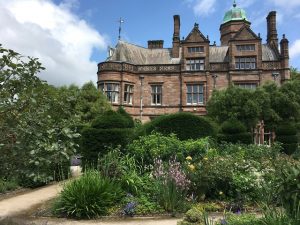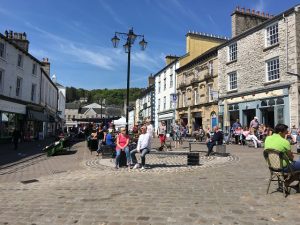Featuring the best attractions in South Cumbria (beyond the Lakes) that are visited by Lake District transport services
The Lake District and Cumbria are home to some of the best scenery and visitor attractions in the country. Outside of the Lake District National Park, south Cumbria has plenty of its own attractions including a number of historic houses, a picturesque coastline and various popular towns which can provide accommodation and onward travel connections to the Lakes.
There are various bus and train services through the area which will transport you to all of the popular attractions described below. Only attractions that are visited by Lake District transport services are included.
Each attraction includes a brief description, photograph, link to website (where available) and any facilities such as shops, cafes and toilets. Public transport services that stop nearby (within 1 mile) are listed and the location of each stop in relation to the attraction is described. Further information on each transport service, including route maps, timetable links and other attractions visited on route, can be found by following the transport service link.
Most of the towns listed have extensive local bus services but only those that have Lake District connections are included.
South Cumbria beyond the Lakes
Attractions summary
Select attraction for further detail
* Arnside – Attractive seaside village overlooking the Kent estuary
* Barrow-in-Furness – Historic industrial town at the south west tip of Cumbria
* Cartmel – Quaint village on the Cartmel peninsula
* Dalton-in-Furness – Ancient market town, historic capital of Furness
* Furness Abbey – Impressive ruined Abbey on the Furness peninsula
* Grange-over-Sands – Attractive seaside town overlooking Morecambe bay
* Holker Hall – Impressive stately home and gardens on the Cartmel peninsula
* Kendal – Historic market town, gateway to the Lakes
* Levens Hall – Impressive stately home and topiary gardens near Kendal
* Sizergh Castle – Impressive stately home and gardens near Kendal
* South Lakes Safari Zoo – Popular wildlife attraction on the Furness peninsula
* Ulverston – Historic market town on the Furness peninsula
South Cumbria beyond the Lakes - Attractions Map
Select icon on left side of top map bar for map key
South Cumbria beyond the Lakes - Attractions
Arnside village

Arnside is an attractive small Victorian resort on the River Kent estuary in the upper reaches of Morecambe Bay. The main attraction is the short promenade along the shoreline which provides a pleasant stroll. There are a few small shops, cafes and a couple of pubs which make the most of the fabulous views across the estuary and beyond towards the Lake District mountains. The village was once a small port and the small pier remains with some pleasant seating. Another feature is the impressive railway viaduct which takes trains across the estuary to Grange over Sands.
The shape of the estuary and high tidal range mean the tide can come in very quickly which sometimes results in a small tidal bore. A siren warns of this event. When the tide is out there are vast expanses of sand and mud across the estuary, either side of the River Kent channel. The village is within the Arnside and Silverdale Area of Outstanding Natural Beauty, an area with wonderful flora, fauna, limestone and coastal scenery. There are some great walks around Arnside, including along the shoreline or up Arnside Knott behind the village which provides superb views over Morecambe Bay. Toilet facilities on the promenade.
The railway station is at the northern end of the village.
Barrow-in-Furness town

The large industrial town of Barrow-in-Furness stands in an isolated but attractive location at the tip of the Furness peninsula. It was just a small fishing village in the early 19th century but was transformed following the arrival of the Furness Railway in 1846 which allowed a large iron and steel industry to develop. As the steelworks boomed, they apparently grew to be the largest in the world. On the back of this, a large shipbuilding industry flourished and docks were built in the sheltered strait between Barrow and Walney Island. The population soared from 450 in 1851 to 47,000 in 1881. Shipbuilding continued to grow, as did the population, reaching a peak of around 82,000 during the first world war. During the second world war Barrow was a target for the German air force who tried to disable the shipyards.
Nowadays the population has decreased to around 56,000. Although not as busy as they once were, the huge shipbuilding works still dominate the town and are renowned for producing some of the most advanced Nuclear Submarines in the world. The town itself isn’t the prettiest but is worth some exploring. The majority of the town centre was planned and built during the boom period and the grid structured wide streets are testament to this. There are some impressive Victorian buildings, including the large Town Hall, made from local red sandstone. There is also a good selection of shops, refreshments and a large indoor market.

A short walk from the town centre and situated over an old dry dock in the shadow of the massive Devonshire Dock Hall indoor shipbuilding facility is Barrow Dock Museum. This impressive free museum is a great place to discover the interesting history of the local area, including the meteoric rise of Barrow due to steel manufacture and shipbuilding during the 19th century, plus the German bombing of the town and shipyards during the second world war. Long before that there was a Viking influence in the area, before the monks of Furness Abbey settled in the 12th century. There are various exhibitions, displays and films telling the story and the modern facility makes it an enjoyable experience. The scale models of various ships that have been built in the town are certainly impressive. Outside, there is a landscaped waterfront area with picnic tables, play area and walks alongside Walney Channel. Open all year, Wednesday to Sunday. There is a cafe and toilet facilities for visitors.
Buses stop at the Town Hall and at a number of other stops through the town. Only bus services that visit Lake District attractions are included. The railway station is on the northern edge of the town centre.
Cartmel village

The pretty and ancient village of Cartmel is something of a hidden gem, set amongst fields on the Cartmel Peninsula, with a delightful village square, some lovely old buildings and various visitor attractions. The main draw for visitors is the horse racing, held at the picturesque racecourse, with a few meetings each year including spring and summer bank holiday weekends. During these events the village becomes unbearably busy but the rest of the year is more sedate. The centrepiece of the village itself is the impressive 12th century Cartmel Priory which has a fascinating history and is well worth exploring. The village is well provided with good eating and drinking establishments, including the renowned L’Enclume restaurant, and is also famous for its own sticky toffee pudding available at the village shop.
Buses stop in the village. No buses at weekends or public holidays.
Dalton-in-Furness

The ancient market town of Dalton-in-Furness was once the major town of the Furness area. Its development owed much to the nearby Furness Abbey and the monks who used the settlement as a centre for administration and justice. The 14th century Dalton Castle is short distance west of the town centre, along Market Street. It was built as a compact Pele Tower for protection against raiders. After the dissolution of the Abbey in 1537, the castle continued as a courthouse for over 300 years and was eventually given to the National Trust in 1965. The castle houses a small free museum but is only open Saturday afternoons from Easter to the end of September. In front of the castle is the old market place with an impressive Victorian drinking fountain and stone cross. Behind the castle is the attractive red sandstone St Mary’s Church. The pleasant town is worth some exploring with its interesting buildings and different shops.
Buses stop at a number of places through the town, including Market Street. The train station is a few minutes walk south of the town centre.
Furness Abbey

The impressive ruins of Furness Abbey stand in a picturesque and peaceful valley on the outskirts of Barrow. Founded in the 12th century, the Abbey soon grew and acquired vast amounts of land as far afield as the Isle of Man, reached by boat via Piel island, and Borrowdale, reached by packhorse trails over the fells. The Abbey eventually became the second richest Cistercian Abbey in England, behind Fountains Abbey in Yorkshire. The period ended in dramatic fashion with the dissolution of the monasteries by King Henry VIII in the 1530’s, when he seized much or their wealth and destroyed most of their buildings.
Much of the huge red sandstone structure has disappeared but there is still plenty to see and English Heritage provides guides telling you more as you wonder around. There is an entrance fee (free for English Heritage members), although a good external view can be had from the adjacent public road, and from the nearby grassy hill, and from Abbey Mill cafe which provides refreshments. Behind the cafe, a short path leads to the 15th century Bow Bridge which carried an old packhorse route over Mill Beck to the Abbey. The Abbey itself has a visitor centre with shop, exhibition and toilets. It is open daily Easter-November, otherwise weekends only.
Buses stop on nearby Abbey Road, leaving a walk of approx 0.4 miles.
Grange-over-Sands town

Grange-over-Sands is an attractive seaside town overlooking Morecambe Bay. The town became a popular Victorian resort after the railway was built in the mid-19th century and many of the buildings, including some grand hotels, date from that period. On the other side of the railway line, the mile-long traffic free promenade provides a pleasant walk with good views across the estuary towards Arnside Knott and the hills of northern Lancashire. Despite the town name, the adjacent sands have been covered by grass in recent history due to the River Kent channel shifting away. Adjacent to the railway station are the pretty ornamental gardens and an impressive duck pond. Away from the estuary, the town is surprisingly hilly and there are some quite strenuous walks up the attractive wooded hills behind. The town itself has a number of small shops and cafes, including the popular Hazelmere Cafe & Bakery and the renowned Higginsons Butchers.
The main bus stop is outside the railway station at the northern end of the town centre.
Holker Hall & Gardens

Holker Hall is a superb stately home set within equally superb gardens and parkland. The original house dates from the 16th century but has been added to since then to create the current building. The west wing was completely destroyed by fire in 1871 but was rebuilt and that part of the house is now open to the public and makes a fascinating open tour. The rest of the house is the private residence of the Cavendish family. Outside are 25 acres of wonderful landscaped gardens and beyond those is attractive parkland. There is also a food hall, cafe, gift shop and toilets set in the courtyard area. Open daily, except Mondays & Tuesdays, from March to October. Also open bank holiday Mondays within that period. Admission fee applies.
Buses stop at nearby Cark from where there is approx 0.6 miles walk. No buses at weekends or public holidays. Cark railway station is approx 0.9 miles walk.
Kendal town

The historic market town of Kendal, located at the south east Lake District boundary, is often referred to as ‘the gateway to the Lakes’ due to its position, or ‘the auld grey town’ due to the many old limestone buildings (rather than the climate!). Its other claim to fame is of course Kendal Mintcake which has long supported mountaineers and walkers worldwide. Lake District visitors often miss the town as they speed past on the A591 bypass, but it is an interesting place to explore with a number of attractions.
The town has a myriad of old alleys and buildings and there are plenty of good shops, cafes and pubs. The River Kent runs through the town with pleasant walks along its banks. Castle Hill, across the river from the town centre, is home to the ruined Kendal Castle and has some wonderful views over the surrounding area. At the southern end of the town centre is the huge Parish Church, Museum of Lakeland Life & Industry and Abbot Hall Art Gallery. Also worth visiting is Kendal Museum and The Brewery Arts Centre which has an interesting and varied selection of events.
Kendal railway station and the main bus station are within the town centre. Oxenholme railway station is approx 1.5 miles outside the town centre, regular local bus services run between the two. Only bus services that visit Lake District attractions are included.
Levens Hall & Gardens

Levens Hall is a fabulous stately home and estate with world famous gardens. Home to the Bagot family since the late 19th century, you can tour certain parts of the house, admire its ornate interior and learn its fascinating history, from its origins as a 13th century Pele tower. House guides are on hand to tell you more along the way. Outside, the main attraction is the large ancient topiary garden which dates from the late 17th century and is apparently the oldest in the world. There are some wonderful shapes to behold and it is well worth a visit.
The estate extends across the A6 to Levens Park which follows the picturesque River Kent upstream and provides an enjoyable walk in parkland occupied by deer and rare Bagot goats. There is also a cafe, gift shop and toilets for visitors. House and gardens open daily, except Saturdays, from Easter to October. Cafe and gift shop open daily all year, except late December and early January. Admission fee applies to house and gardens.
555 & 755 buses stop on the A6 near the main gates. 530 & X6 buses stop on the A590 near Heaves Hotel, approx 1 mile walk.
Sizergh Castle & Gardens

Sizergh Castle is an impressive stately home and estate, now owned by the National Trust but occupied by the Strickland family since the 13th century. It is very close to the main A591 but well hidden from the road and is well worth exploring. Originally just a Pele tower, the house has been extended over the centuries to provide a home to the owners but you can still tour much of the property and there are volunteer guides to help you.
Outside, there is a lovely garden, including a limestone rock garden and a large pond in front of the castle. Beyond this there are some good walks around the huge estate. There is also a cafe, gift shop, picnic tables and toilets adjacent to the car park. Castle open daily, except Mondays, from March to October. Open Bank Holiday Mondays. Gardens, shop, cafe open daily except early January. Admission fee applies.
On the opposite side of the A591 is Low Sizergh Barn, a popular farm shop and cafe. This is a short walk from the main castle gates, on the minor road under the A591 and turn left just beyond.
Buses stop on the main A590 at Brettagh Holt roundabout leaving a walk of just under 1 mile. Follow the signs for Sizergh Castle along the nearby lane, passing the popular Strickland Arms pub.
South Lakes Safari Zoo

South Lakes Safari Zoo is a popular wildlife attraction for all the family. The zoo is adjacent to, but well hidden from, the main A590 and has greatly expanded over the years. There are a huge variety of wildlife around the large site, including big cats, giraffes, rhinos, monkeys and South American birds. In some areas of the zoo you can actually mingle with the less dangerous animals, and various zoo keeper and feeding experiences are available for additional cost. The zoo is open daily all year and there are many facilities, including play area, food outlets, gift shop and toilets. Entrance fee applies.
Buses stop on the main A590, only a short walk from the entrance. The railway station is in nearby Dalton-in-Furness, approx 1.5 mile walk or bus ride.
Ulverston town

The historic market town of Ulverston has a number of attractions for visitors and is worth some exploring. There are plenty of old cobbled streets, interesting buildings, shops, cafes and pubs. It is all centred on the attractive market place which still holds regular markets every Thursday and Saturday. The town is famous as the birthplace of Stan Laurel, born Arthur Stanley Jefferson in 1890. The fascinating Laurel & Hardy Museum is dedicated to the famous comedy duo and an impressive statue of them stands outside the nearby Coronation Hall, an arts, culture and entertainment venue.

On the hill overlooking the town is the eye-catching Hoad Monument, a replica of the Eddystone lighthouse, which can be seen from miles around. The monument is a fairly short but strenuous walk from the town and is worthwhile for the magnificent views of the town and surrounding area. A flatter walk can be had along the old canal which is a pleasant stroll just over 1 mile to the picturesque Leven estuary. The canal was the shortest, widest and deepest in the country and a reminder of the importance of the town as a port before the railway was built.
Buses stop on Victoria Road in the town centre. Only bus services that visit Lake District attractions are included. The train station is slightly south of the town centre, approx 0.3 miles walk.





